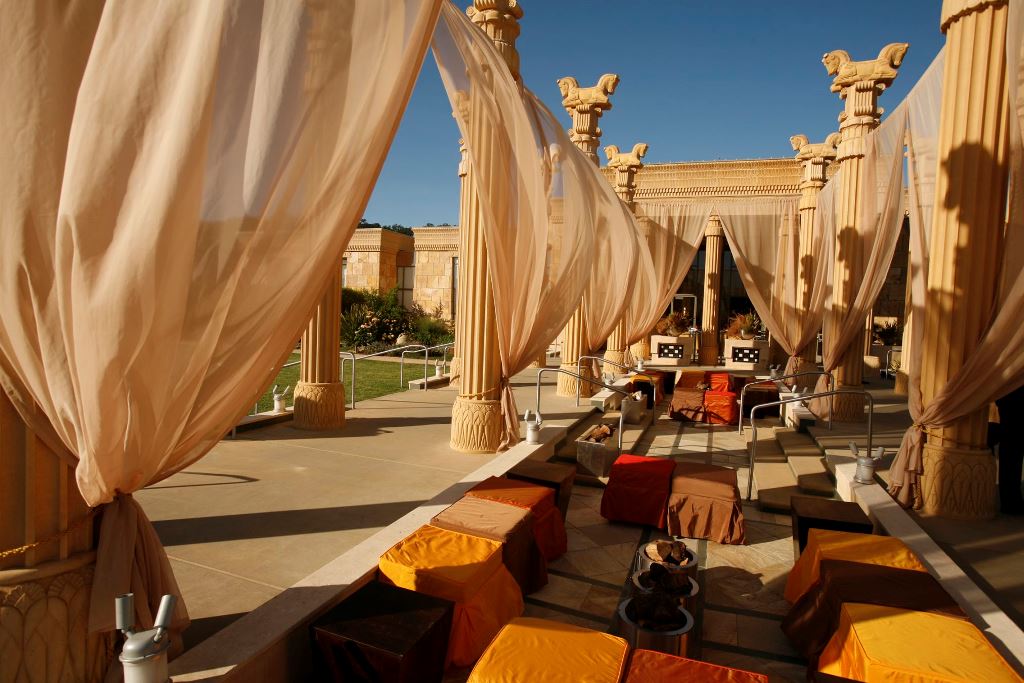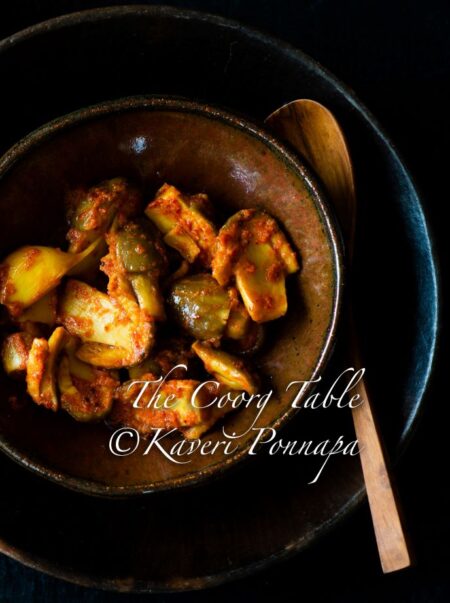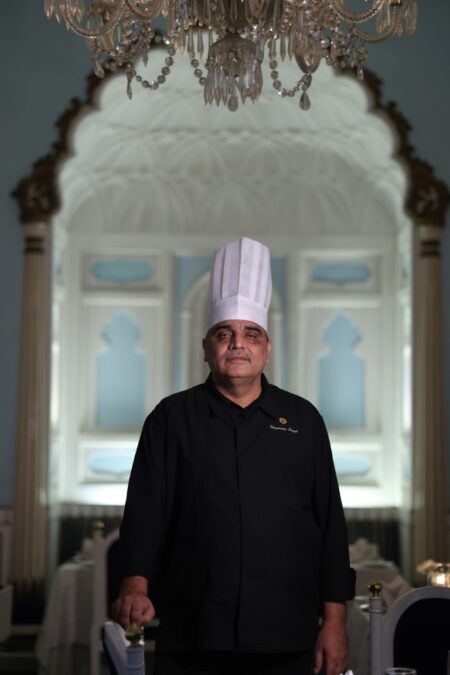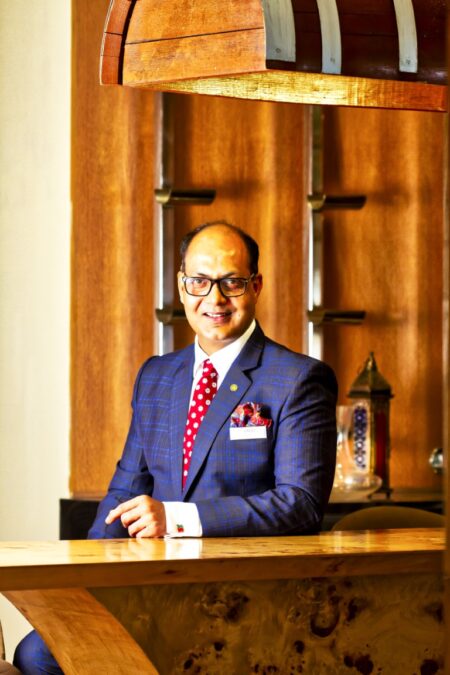In Napa, with its dun coloured hills covered in clumps of dark, dense scrub oak, and never ending acres of vineyards, Darioush is most unexpected and dramatic. Sixteen freestanding columns of golden stone, eighteen feet high, rise proudly against a blue sky, bringing all the glories of the ancient Persian Empire instantly to mind. The beautiful stone, quarried from the Persepolis region, fountains, flowing water and an air of restrained luxury and elegance welcome us at Darioush. In a region of literally hundreds of wineries, many of them iconic, internationally renowned, others hidden treasures, learnt of by word of mouth, there are no easy choices. For every one winery you visit, there are many more you have to regretfully pass by. To a winery that employs “hand harvesting and sorting; small lot whole cluster pressing; de-stemming; cold soaking; extended maceration; barrel to barrel racking and bottling without filters,” Shiraz born Darioush Khaledi brings a Persian sensibility in the architecture, cultural references and aesthetics. The tasting rooms are amongst the most elegant in Napa, all glass and golden stone, with constant references to Persia – in the books, statuary, artifacts and even cookbooks that fill the space. Against a backdrop of well-modulated music and the sound of flowing water, we are presented a flight of five wines by the thoroughly professional and friendly staff, that includes a pale gold, richly aromatic Darioush 2010 Signature Chardonnay; the hugely popular 2011 Signature Viogner, full of floral notes of jasmine, honeysuckle and orange blossom, shot through with spice, and the Signature Merlot, a deep, complex wine with hints of violets, lavender, succulent dark plums, figs and blueberries, leather and spice. In the cellars, where a rough cross section of volcanic rock has been left open to view, to speak of the origins of the flavours in our glasses, we taste the 2008 Signature Cabernet Sauvignon, made from grapes hand –harvested into 28 lb. baskets, and hand sorted, twice. This wine expresses notes of dark chocolate, coffee, and yields up layer after layer of lavender, dark fruit and sage – our choice from the tasting. 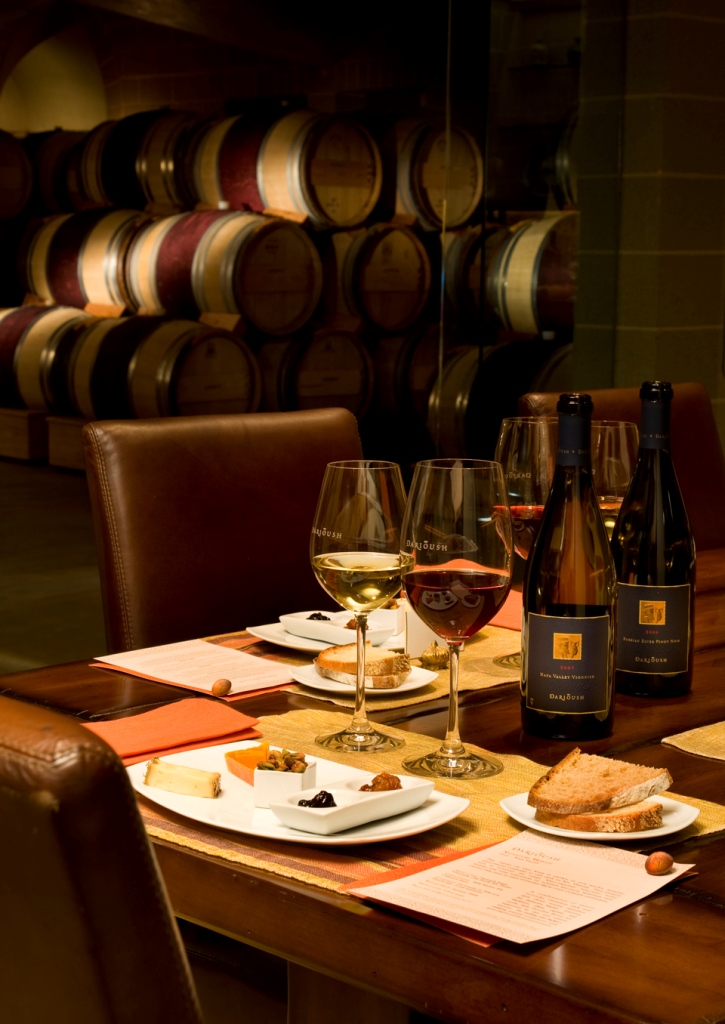 The labels for the Darius II Cabernet Sauvignon, declared the Crown Jewel of the Darioush Estate depicts the Persian hero Rostam, and his rose coloured stallion, a perfect choice for a creation hand selected from barrel lots, known for its rich, regal style -the 2007 Darius II, was rated an impressive 96 and 94 by Wine Spectator and Robert Parker, respectively.
The labels for the Darius II Cabernet Sauvignon, declared the Crown Jewel of the Darioush Estate depicts the Persian hero Rostam, and his rose coloured stallion, a perfect choice for a creation hand selected from barrel lots, known for its rich, regal style -the 2007 Darius II, was rated an impressive 96 and 94 by Wine Spectator and Robert Parker, respectively. 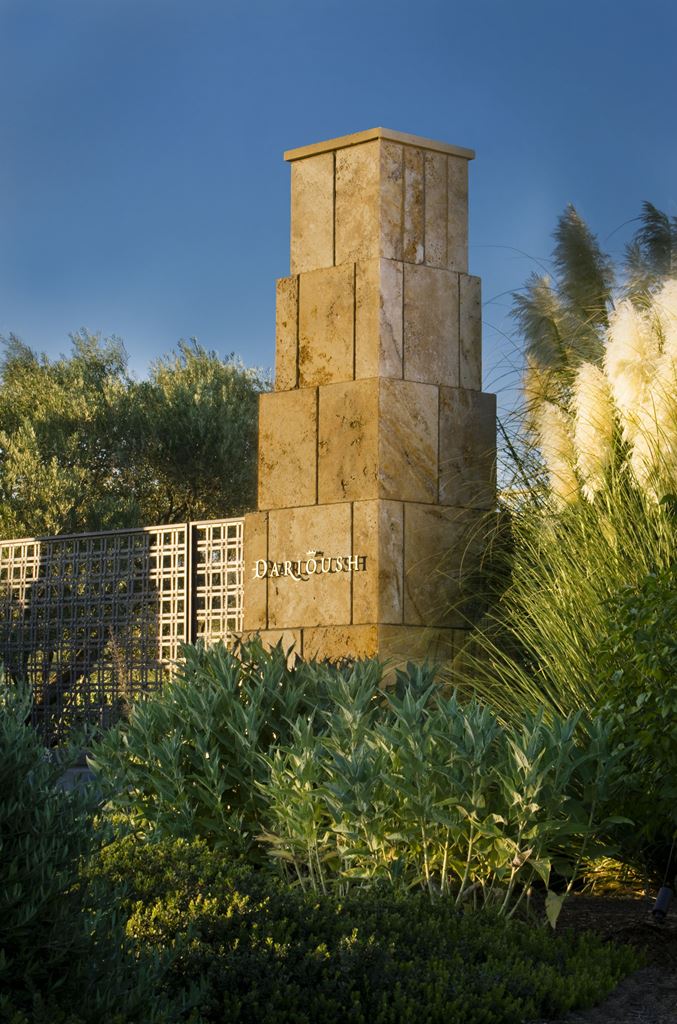 At James Cole – a name coined form James and Colleen (Cole) Harder, the owners of this superb, niche, winery – we are fortunate to meet Lisa Hurt, the ebullient, capable Tasting Room Manager. Since we are already well into our tastings for the day and the James Cole flight offers eight wines, Lisa guides us through them. This is a family owned, small production winery, but there is a lot to hold your attention here. The 2009 James Cole Il Mostro Proprietary Red Wine with a total production of 146 cases is a blend of Petite Sirah and Zinfandel, “plush, rich and round” revealing “cocoa bean, dark fruits coconut and chocolate covered blueberries on the nose.” This is a deep, rich wine, with balance, structure and acidity, opening up to “raspberries, anise, cherries and white chocolate.” There is the superb 2008 Malbec – a 220 case production – dark and rich, with lavender, truffles and dark berries on the nose, yielding up complex layers of plum, blackberries, pomegranate, chocolate and coffee, with perfect balance and structure.
At James Cole – a name coined form James and Colleen (Cole) Harder, the owners of this superb, niche, winery – we are fortunate to meet Lisa Hurt, the ebullient, capable Tasting Room Manager. Since we are already well into our tastings for the day and the James Cole flight offers eight wines, Lisa guides us through them. This is a family owned, small production winery, but there is a lot to hold your attention here. The 2009 James Cole Il Mostro Proprietary Red Wine with a total production of 146 cases is a blend of Petite Sirah and Zinfandel, “plush, rich and round” revealing “cocoa bean, dark fruits coconut and chocolate covered blueberries on the nose.” This is a deep, rich wine, with balance, structure and acidity, opening up to “raspberries, anise, cherries and white chocolate.” There is the superb 2008 Malbec – a 220 case production – dark and rich, with lavender, truffles and dark berries on the nose, yielding up complex layers of plum, blackberries, pomegranate, chocolate and coffee, with perfect balance and structure. 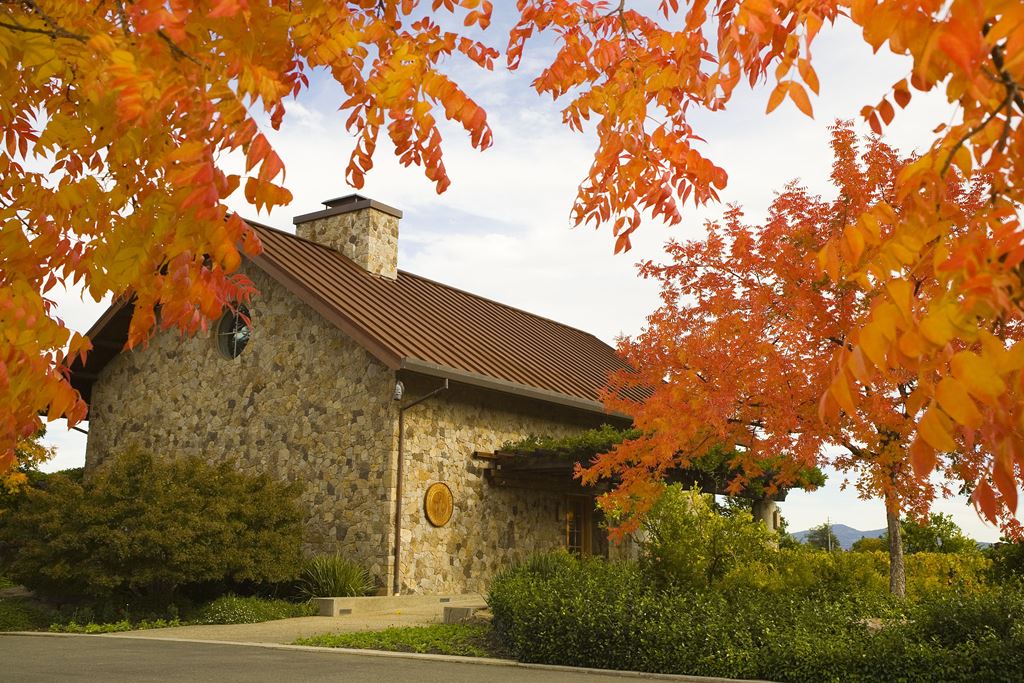 “Big, dark, brooding, polished and perfumey, all wrapped around gorgeous structure and silky tannins” is how James Cole describe their 2009 Aliento Proprietary Red Wine, a blend of 45% Cabernet Sauvignon; 23%Merlot; 19% Malbec; 13%Cabernet Franc and 2% Petit Verdot. With lilacs, truffles and black currents on the nose, and a palate of black cherries, blackberries, plumy flavours and a lasting finish, this is stunning wine, while the James Cole Umbral Cabernet Sauvignon showcases the best of the estate, by isolating 5-6 barrels that stand above the best of the production, for an additional six months ageing, before beginning clonal blending, for a darker, richer, riper wine with a long ageing potential.
“Big, dark, brooding, polished and perfumey, all wrapped around gorgeous structure and silky tannins” is how James Cole describe their 2009 Aliento Proprietary Red Wine, a blend of 45% Cabernet Sauvignon; 23%Merlot; 19% Malbec; 13%Cabernet Franc and 2% Petit Verdot. With lilacs, truffles and black currents on the nose, and a palate of black cherries, blackberries, plumy flavours and a lasting finish, this is stunning wine, while the James Cole Umbral Cabernet Sauvignon showcases the best of the estate, by isolating 5-6 barrels that stand above the best of the production, for an additional six months ageing, before beginning clonal blending, for a darker, richer, riper wine with a long ageing potential. 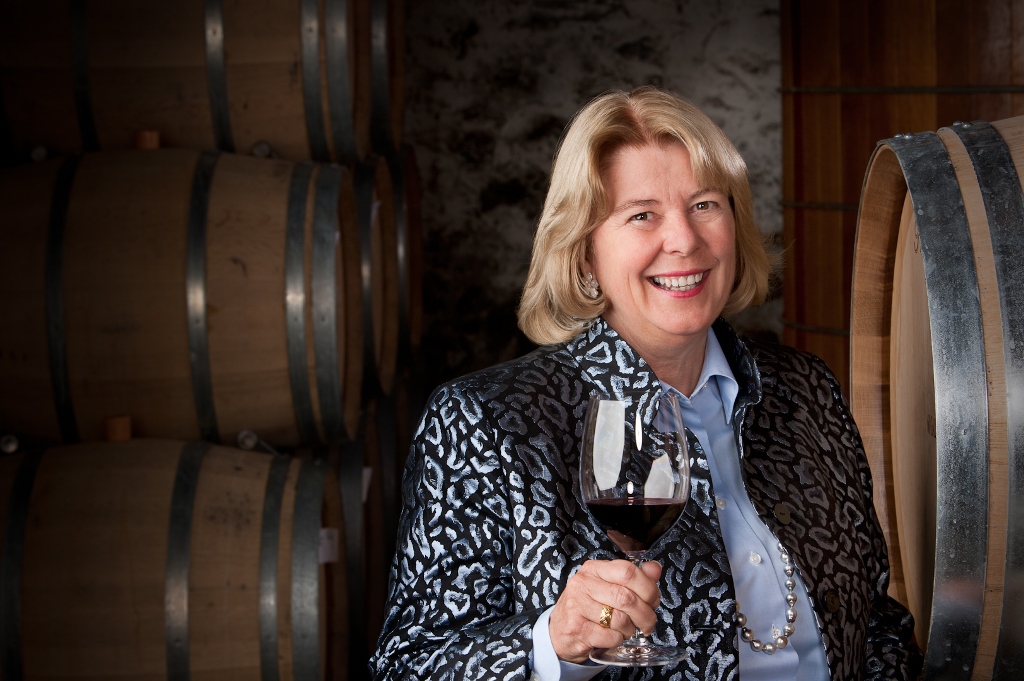 For a relatively young wine producing area, Napa is full of interesting pockets of history. A small stone building off the St.Helena highway is the tasting and sales room for Heitz Wine Cellars, one of the most historically significant in the region. The Martha’s Vineyard Cabernet Sauvignon from Heitz was the first vinery-designated wine in the Napa Valley. This iconic wine is produced from fruit sold exclusively to Heitz from a plot owned by Tom and Martha May; three generations of winemakers from the Heitz family and the May family, have collaborated to produce this wine ranked by Wine Spectator as “one of the top twelve wines of the 20th century.” This is one of the prettiest locations, planted around with coral bells, lavender and wisteria looking onto acres of vineyards. You can carry your glass of wine and sit beside a slowly – rotating millstone fountain looking out at the vine covered countryside.
For a relatively young wine producing area, Napa is full of interesting pockets of history. A small stone building off the St.Helena highway is the tasting and sales room for Heitz Wine Cellars, one of the most historically significant in the region. The Martha’s Vineyard Cabernet Sauvignon from Heitz was the first vinery-designated wine in the Napa Valley. This iconic wine is produced from fruit sold exclusively to Heitz from a plot owned by Tom and Martha May; three generations of winemakers from the Heitz family and the May family, have collaborated to produce this wine ranked by Wine Spectator as “one of the top twelve wines of the 20th century.” This is one of the prettiest locations, planted around with coral bells, lavender and wisteria looking onto acres of vineyards. You can carry your glass of wine and sit beside a slowly – rotating millstone fountain looking out at the vine covered countryside. 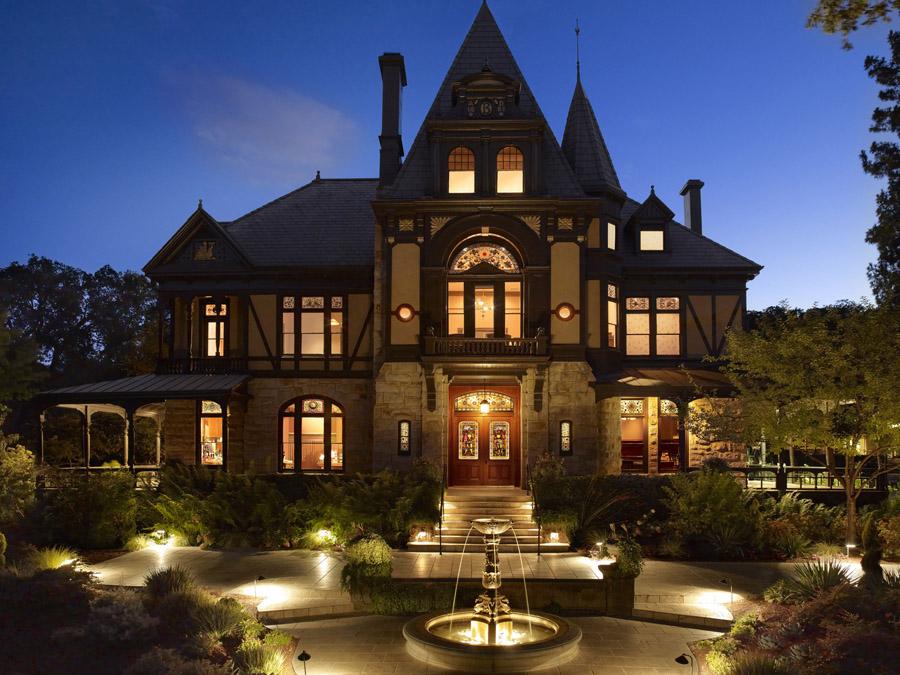 The Tasting Room staff are particularly helpful, offering a 2010 Chardonnay, showing tropical flavours, citrus notes and a long, smooth finish. There is the outstanding 2009 Grignolino, with the flavours of crushed strawberries and spice, and a long finish. Joe Heitz, who bought the small winery surrounded by Grignolino grapes, in 1961 trained under the legendary André Tchelistcheff, a French trained Russian oenologist. The Grignolinos Heitz produced were so good that, Angelo Gaja, of Barbaresco fame, exported them to Italy. We also appreciate the 2006 Bella Oaks Vineyard Cabernet Sauvignon, fruity, with notes of plum and Limousin oak, smooth tannins and a lingering finish, and the 2003 Trailside Vineyard Cabernet Sauvignion that boasts a “lavish bouquet of bold blackberry, dried anise and notes of cedar.” There are notes of dark fruit, and once again, Limousin oak from an extended aging. We conclude with one of the historic wines of Napa, first made by Joe Heitz in 1966: the 2000 Martha’s Vineyard Cabernet Sauvignon, aged one year in American oak tanks, and two-and-a-half years in French Limousin oak barrels, a Cabernet Sauvignon that is world-renowned, in the words of Kathleen Heitz Mayers, “for its unique mintiness, rich layers of complexity and remarkable overall balance.”
The Tasting Room staff are particularly helpful, offering a 2010 Chardonnay, showing tropical flavours, citrus notes and a long, smooth finish. There is the outstanding 2009 Grignolino, with the flavours of crushed strawberries and spice, and a long finish. Joe Heitz, who bought the small winery surrounded by Grignolino grapes, in 1961 trained under the legendary André Tchelistcheff, a French trained Russian oenologist. The Grignolinos Heitz produced were so good that, Angelo Gaja, of Barbaresco fame, exported them to Italy. We also appreciate the 2006 Bella Oaks Vineyard Cabernet Sauvignon, fruity, with notes of plum and Limousin oak, smooth tannins and a lingering finish, and the 2003 Trailside Vineyard Cabernet Sauvignion that boasts a “lavish bouquet of bold blackberry, dried anise and notes of cedar.” There are notes of dark fruit, and once again, Limousin oak from an extended aging. We conclude with one of the historic wines of Napa, first made by Joe Heitz in 1966: the 2000 Martha’s Vineyard Cabernet Sauvignon, aged one year in American oak tanks, and two-and-a-half years in French Limousin oak barrels, a Cabernet Sauvignon that is world-renowned, in the words of Kathleen Heitz Mayers, “for its unique mintiness, rich layers of complexity and remarkable overall balance.” 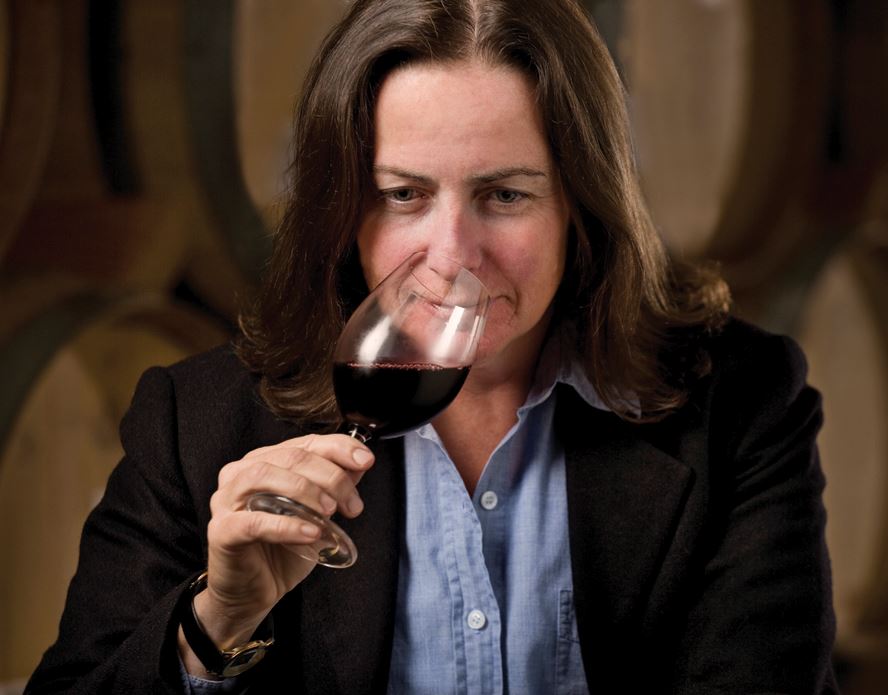 Going deeper into the history of the region, we make our way to Beringer Vineyards, the oldest operating vinery in Napa. Set in grounds and gardens of stately grace and beauty, the 1883 Rhine House is a seventeen -room mansion of redwood, brick and stucco with a gabled roof and Belgian stained glass, reflecting the German heritage of the founders. Jacob and Frederick Beringer, who came to Napa in 1876, found the rocky, well –drained soils similar to their native Rhine Valley. So with the help of Chinese railroad workers, tunnels were carved out of hillsides for storing and aging wines, and a winery was created. This is a little piece of Europe planted in the Californian countryside, the Rhine House a brooding presence over the abundant gardens and grounds, cut into the hillside. The consistently high standards of winemaking achieved by Beringer are reflected in the wines offered at the Reserve Tasting Bar at the Rhine House, a flight of four wine, all rated above 90 points by either Robert Parker, or Wine Spectator. Our choice was the 2007 Chabot, a 100% Cabernet Sauvignon – 93 points, Robert Parker – highly structured, with notes of black current, mint and cedar, followed by the 2006 Private Reserve Cabernet Sauvignon, with its notes of warm spices, nutmeg, licorice, cassis and cocoa, and an extremely elegant finish.
Going deeper into the history of the region, we make our way to Beringer Vineyards, the oldest operating vinery in Napa. Set in grounds and gardens of stately grace and beauty, the 1883 Rhine House is a seventeen -room mansion of redwood, brick and stucco with a gabled roof and Belgian stained glass, reflecting the German heritage of the founders. Jacob and Frederick Beringer, who came to Napa in 1876, found the rocky, well –drained soils similar to their native Rhine Valley. So with the help of Chinese railroad workers, tunnels were carved out of hillsides for storing and aging wines, and a winery was created. This is a little piece of Europe planted in the Californian countryside, the Rhine House a brooding presence over the abundant gardens and grounds, cut into the hillside. The consistently high standards of winemaking achieved by Beringer are reflected in the wines offered at the Reserve Tasting Bar at the Rhine House, a flight of four wine, all rated above 90 points by either Robert Parker, or Wine Spectator. Our choice was the 2007 Chabot, a 100% Cabernet Sauvignon – 93 points, Robert Parker – highly structured, with notes of black current, mint and cedar, followed by the 2006 Private Reserve Cabernet Sauvignon, with its notes of warm spices, nutmeg, licorice, cassis and cocoa, and an extremely elegant finish.  The defining moment in Californian winemaking history, described by Barbara Ensrud as “a vinous shot heard around the world” was, of course, the 1976 Judgement of Paris, that catapulted Californian wines to international fame. At Stag’s Leap, we meet the incredibly helpful and friendly Troy Huckins, who guides us through the famous Stag’s Leap caves, the entrance designed by Javier Barba, the Barcelona architect where, in addition to the barrels of wine, there are metal sculptures and a Foucault pendulum, that marks the ” passing of time and the ageing of wine.” A short climb gives onto ravishing views across the S.L.V. parcel, with its volcanic soil from where some of the iconic wines come. We are introduced to Cask 23, named after the original lot of ageing wine that was so distinct, that it was set aside to be bottled separately by the late Andre Tchelistcheff, and Fay, named after Nathan Fay, the pioneering winegrower who planted the first Cabernet vineyards.
The defining moment in Californian winemaking history, described by Barbara Ensrud as “a vinous shot heard around the world” was, of course, the 1976 Judgement of Paris, that catapulted Californian wines to international fame. At Stag’s Leap, we meet the incredibly helpful and friendly Troy Huckins, who guides us through the famous Stag’s Leap caves, the entrance designed by Javier Barba, the Barcelona architect where, in addition to the barrels of wine, there are metal sculptures and a Foucault pendulum, that marks the ” passing of time and the ageing of wine.” A short climb gives onto ravishing views across the S.L.V. parcel, with its volcanic soil from where some of the iconic wines come. We are introduced to Cask 23, named after the original lot of ageing wine that was so distinct, that it was set aside to be bottled separately by the late Andre Tchelistcheff, and Fay, named after Nathan Fay, the pioneering winegrower who planted the first Cabernet vineyards. 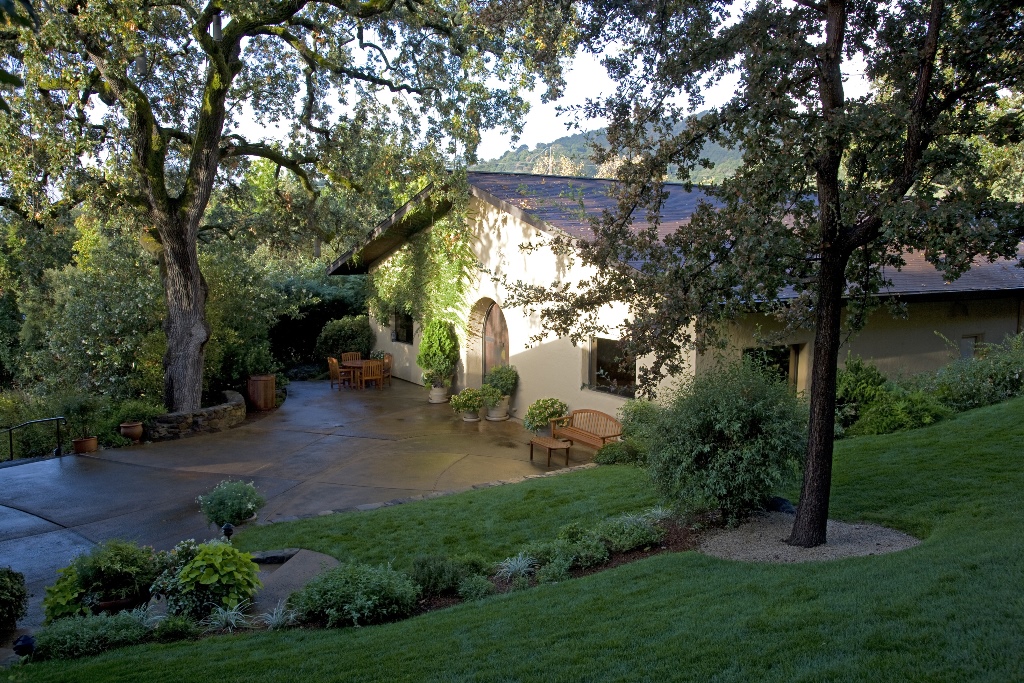 Stag’s Leap is known for its outstanding, Estate grown Cabernet Sauvignons, and winemaker Nicki Pruss says “Our aim is to create wines of classic beauty – wines of balance, complexity and harmony.” And that’s what we taste in the 2006, Stag’s Leap Wine Cellars S.L.V Block 4.
Stag’s Leap is known for its outstanding, Estate grown Cabernet Sauvignons, and winemaker Nicki Pruss says “Our aim is to create wines of classic beauty – wines of balance, complexity and harmony.” And that’s what we taste in the 2006, Stag’s Leap Wine Cellars S.L.V Block 4. 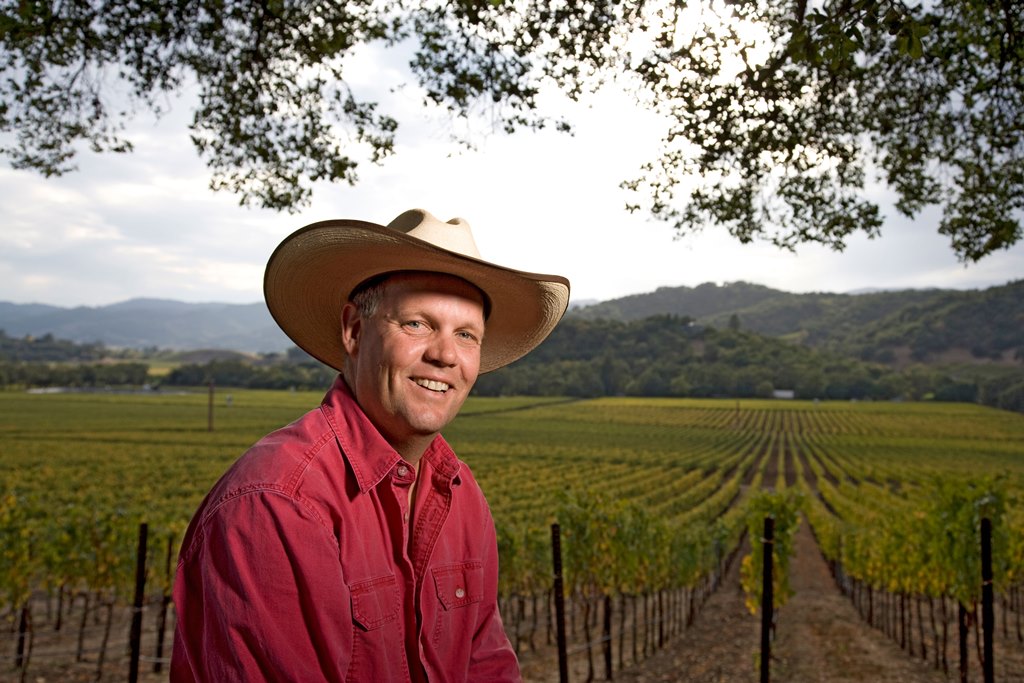
Napa wineries offer an extraordinary range of experiences. Architectural styles, range from the ultra modern to Spanish Mission; there are rich collections of art at some; there are tiny, family run wineries and large, slick ones. Most of them offer escorted tours, and it is possible to book for pairings, tours of caves and vineyards – prior appointments will ensure a smooth visit. Many, like Darioush, have dramatically beautiful private dining spaces in their cellars, which can be booked for an event. Just driving along the Silverado Trail, that was once an old horse trail, puts a good distance between you and the crowds, taking you deep into shining, wine country, and many wineries,like Signorello, offer beautiful views of the surrounding countryside.
Robert Mondavi, with its Spanish Mission architecture, a tribute to the Franciscan Fathers who planted the first grapes, attracts large crowds. You walk through that famous arch, past the bell tower with streams of people, into expansive views of the To Kalon – from the Greek for ‘beautiful’ – vineyards that surround the winery. The public spaces here are dotted with sculptures by Beniamino Bufano, with antique doors, a wooden wine press, and the To Kalon Reserve Tasting room that we opt for is full of colonial furniture that adds to the atmosphere of mellow age and luxury. Robert Mondavi hosts wine tastings, wine basics, exclusive reserve tastings, concerts and much more, is perhaps one of the most popular wineries. But there are innumerable small treasures to be unearthed, in family run and boutique wineries, which is what we would recommend, especially for returning visitors. With the Culinary Institute of America located in Napa, the dining options are difficult to top. And there’s nearby Yountville, where some of the world’s iconic restaurants are located – Ad Hoc, Bouchon, The French Laundry, Morimoto, to name just a few. And if you prefer something more informal, there’s Dean and Deluca, to stock up on the perfect picnic, which leaves you with the freedom to drive around the beautiful countryside, and have a quiet meal between tastings. And that taste of Napa will have you quickly planning for more.
This article appeared in UpperCrust magazine October-December 2012
Image Credits: Courtesy Darioush;Heitz Cellars; Stag’s Leap Wine Cellars; Beringer Vineyards.

